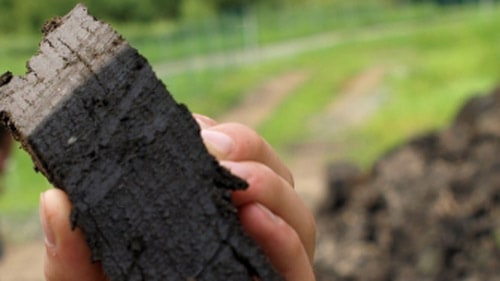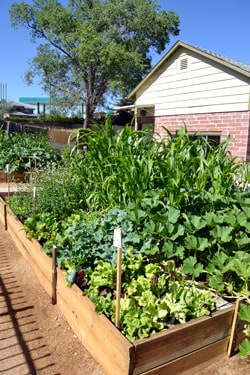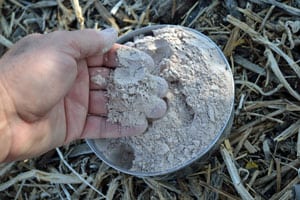Terra Preta- Magic Soil of the Lost Amazon
What is the Best Way to Build the Health and Resiliency of my Garden Soil?
This is an exploration on how best to build your garden soil. These are the results of much reading, experimenting and talking with several people who have been engaged in this exact pursuit for over 30 years. Our personal experiences span 20+ years, from rangeland monitoring for Holistic Resource Management, to researching how long it takes to build soil in the arid South West, to examining and monitoring cryptogammic soil crusts and how they fix nutrients that begin the process of building a foundational soil from rock and sand.
Much has been learned or re-learned in the last 30 years by sustainable and biological large scale farmers. These techniques have been combined with state of the art diagnoses and tests to confirm movement in a positive direction, and to correct drift or fall back. The complex but identifiable chemistry of the interactions and sequencing of specific elements and chemicals show us that nature is much, much more complex and inter-related than we originally thought when we came up with the N-P-K fix-all formula for successful farming.
As one farmer puts it, “It’s not difficult, it’s just different.” This is a different approach for many in creating a healthy garden, in starting with the soil. What we have learned is that everything really does start with the soil. Not only the health of the plant, and the attending nutrition that the produce has; but the pest and disease resistance or lack thereof has its foundation in the soil. Something that the commercial sustainable farmers have discovered- once there is enough copper in the soil that is picked up by the plant, grasshoppers won’t come near the crops. Additionally, insects are attracted to the scent of phosphates, which are given off by diseased or stressed plants. Chemical farming over-utilizes phosphates which worsens the insect attacks, creating more demand for chemical pesticides. Using sustainable, biological farming methods balances the amount of phosphates so that the insects aren’t attracted to the plants. This is all done in and with the soil, not chasing from one perceived “problem” to another. Insects, diseases and weeds are seen as indicators of weakness and imbalance, not problems in and of themselves. This is not to say that there will never be the need to address particular pest or disease or weed issues, but they will be smaller, less frequent, and easier to manage.
One of the basic tenants of any scale agriculture is to get more carbon into the soil. There are three types of carbon- green, brown and black. Green carbon is readily used by the soil and its’ organisms for food and energy. It consists of grass clippings, green manures, and young compost. Brown carbon is a more stable form and consists of dried stalks of plants, straw and dead leaves. This is food for the fungi in the soil. Black carbon is the reserve of the soil and is obtained from decomposed brown carbon and mature, aged compost. It is also obtained from charcoal, or bio-char. This is the basis of creating a vibrant, dynamic and healthy soil structure with its attendant communities of fungi and micro-organisms that all play their parts in making nutrients available to the plants, and getting the plant sap sugars in return.
The first article is on Terra Preta, or black soil that is found in the Amazon, one of the harshest agricultural areas in the world. The soil is heavy clay and the enormous rainfall washes most nutrients off or out of the soil within just a few years. Until finding Terra Preta, that is. The results of people systematically working charcoal into the soils are astounding. This is the basis for creating dynamic, resilient soils in our gardens. Read this first article, and our discussion notes afterward. This is in two segments, with the notes after the second segment.
The original article was published by ACRES USA.
Terra Preta- Magic Soil of the Lost Amazon
by Allan Balliett
It’s like finding a lost chapter from Peter Tompkins and Christopher Bird’s Secrets of the Soil – Terra Preta (literally “black earth”) is a manmade soil of prehistoric origin that is higher in nitrogen, phosphorus, potassium and calcium than adjacent soils. It controls water and reduces leaching of nutrients from the rhizosphere. Rich in humus, pieces of pre-Columbian unfired clay pottery, and black carbon, it’s like a “microbial reef” that promotes and sustains the growth of mycorrhizae and other beneficial microbes, and it has been shown to retain its fertility for thousands of years. In university trials, terra preta has increased crop yields by as much as 800 percent. It regrows itself when excavated. It is even possible to produce carbon-negative usable energy (such as diesel or hydrogen) while making the major input (bio-char) for terra preta on the farm.
If these amazing properties haven’t convinced you that terra preta is important to eco-agriculture, then consider this: experts say that terra preta sequesters carbon at such a high rate that, in the near future, farming with this technique could be eligible for lucrative carbon credits.
Perhaps most amazing, though, is the fact that, unlike many if not most of the eco-ag technologies reported in Secrets of the Soil, the incredible properties of terra preta are not denied by myopic academics. In fact, almost everything we know about terra preta is coming from university studies!
Much is still unknown about terra preta and “Amazonian Dark Earths,” but as the key component of a proposed agricultural system that would both feed starving populations and solve global warming, grant money is coming in to fuel university investigations of the technology. For every unanswered question on terra preta, there appears to already be a funded study underway.
TERRA PRETA DEFINED
Terra preta do indio is a black, earth-like, anthropogenic (manmade) soil with enhanced fertility due to high levels of soil organic matter (SOM) and nutrients such as nitrogen, phosphorus, potassium, and calcium embedded in a landscape of infertile soils. Terra preta soils occur in small patches averaging 20 hectares (50 acres), but 350 hectare (865 acre) sites have also been reported. These 2,000-year-old manmade soils occur in the Brazilian Amazon basin and other regions of South America. Terra preta soils are very popular with the local farmers and are used especially to produce cash crops such as papaya and mango, which grow about three times as rapidly as on surrounding infertile soils.
South American terra preta soils are also full of pieces (sherds) of unfired pottery. It is generally believed that the pottery was introduced into the soil much as modern growers add perlite or sand to potting mix, as a way of keeping the soil from baking completely tight under the tropical sun before a cover of vegetation could grow over it. Much is made of these sherds as “proof” that terra preta deposits are really prehistoric trash piles, but Charles C. Mann asserts there are indications that much of this pottery was actually made specifically for incorporation into the soil.
Associated with terra preta is terra mulata, soils which are lighter than terra preta and tend not to contain cultural artifacts but are said to have similar qualities. Terra preta soils are found near historic settlements, while terra mulata soils are found where agricultural fields were once located. It is assumed that the village- related terra preta is darker because it received continual inputs of household wastes (including humanure), and that terra mulata fields were amended chiefly with bio-char, which was initially created by burning forest cover and later by slow-burning brush, weeds and crop wastes. Because of their overall similarities, terra preta and terra mulata are often grouped under the title “Amazonian Dark Earths” (ADE).
William Devan, a geologist from the University of Wisconsin who is prominent in terra preta research, offers these comments: “The black terra preta is associated with long-enduring Indian village sites, and is filled with ceramics, animal and fish bones, and other cultural debris. The brown terra mulata, on the other hand, is much more extensive, generally surrounds the black midden soils, contains few artifacts, and apparently is the result of semi-intensive cultivation over long periods. Both forms are much more fertile than the surrounding highly weathered reddish soil, mostly oxisol, and they have generally sustained this fertility to the present despite the tropical climate and despite frequent or periodic cultivation. This is probably because of high carbon content and an associated high microbial activity which is self perpetuating.”
Ironically, information about the agricultural value of terra preta is only emerging now because of a paradigm shift among archaeologists that has reevaluated the role of indigenous people (AmerIndians) in the pre-Columbian Americas. Put simply, before contact, there were heavy populations of indigenous people in the Americas, in fact, until the mid-16th century, some of the world’s largest and most sanitary cities were in the Americas. Pre-Columbian Indians made great achievements in architecture, art and agriculture. Not only did they breed many of the economically important plants of today’s world (corn, sunflower, beans, potato, sweet potato, tomato, peanut, avocado, tobacco and cotton), but they also developed incredibly productive methods of agriculture such as raised beds and “three sisters.” As Jerry Brunetti has pointed out, the rate of production of calories by Iroquois agriculture at the time of the New England settlement was unimaginable to Europeans. Not only did the Iroquois Nation produce high-value foods, they were also able to produce enough of it to ensure two to three years’ worth of food in storage at any given time!
What the AmerIndians lacked, unfortunately, was resistance to European diseases. Hard to believe as it is, precontact Amerindians apparently had no human-to-human diseases, with the possible exception of syphilis. According to Charles C. Mann, they didn’t even have the common cold until Europeans arrived. Several waves of deadly diseases (such as small pox and measles) swept through the Americas after Columbus’ first visit, spread not only by subsequent European explorers, but, after contact, by the AmerIndians themselves through their well established, hemisphere-wide, socially motivated trade routes.
By the mid-1500s, most of the indigenous Americans had died as a result of epidemics. Undermined by pain, suffering, superstition and loss of leadership (many important Incan leaders died of European diseases, including the most powerful, which opened the door for Pizarro’s conquest of this powerful empire), AmerIndian society began to collapse. Urban populations could not be fed, and cities were abandoned. In the stone-free Amazon, this meant that metropolises built of wood and soil were absorbed by the jungle at such a rate that areas reported by the first explorer as heavily populated with massive structures were, just 50 years later, reported as jungle wildernesses populated by small bands of scraggly natives.
The bottom line for mainstream archeological interpretation of the history of the Amazon was based on the assumption that the area was a “counterfeit paradise,” with all of its nutrients locked into its canopy, leaving soils poor, acidic and toxic. Although terra preta was described to academic America as early as 1870, rich soils in the Amazon were considered to be an anomaly, the result of prehistoric lakes or hydrological accidents. (An enjoyable period view of the value of Amazon agricultural land can be found in an 1867 book entitled Brazil, the Home for Southerners, by Confederate expatriate Ballard S. Dunn, which lauds the high fertility of Brazil’s Amazonian dark soil among other aspects of “planterlife” in Brazil; it is available online in its entirety through Google Books, www. books.google.com).
Caught in a “believing is seeing” syndrome, archeologists assumed that because typical Amazonian soils were thin and infertile, large populations could never have existed there. Accepting this assumption, they saw no point in looking for evidence of settlement. Betty J. Meggers, the Smithsonian archaeologist, said, “The apparent lushness of the rainforest is a sham. The soils are poor and can’t hold nutrients – the jungle flora exists only because it snatches up everything worthwhile before it leaches away in the rain. Agriculture, which depends on extracting the wealth of the soil, therefore faces inherent ecological limitations in the wet desert of Amazonia.”
Views are changing, however, and a new school of archaeologists, geologists and soil scientists have asserted that the Amazon was in fact heavily populated and that the fertility of terra preta was what made feeding these large groups of people possible. Although many questions remain unanswered, this new school of Amazon investigators feels that there is substantial physical proof that not only was the Amazon rainforest home of very large populations supported by an effective agriculture based on the robust fertility of the manmade terra preta soils, but also that the Amazon forest itself is better thought of as a manmade landscape.
It is important to note that the good news about terra preta is not the news about the physical soils in Brazil. Although soils are illegally mined and sold as potting mix and soil amendments in Brazil and Bolivia, native terra preta is not accessible to U.S. growers. Because they are filled with pre-Columbian artifacts and because they are associated with archaeological sites that have yet to be fully investigated, terra preta cannot be purchased or imported.
The current goal of scientists studying terra preta is to learn what it is and how it works so that it can be replicated anywhere in the world. The focus of most of this work, however, is not on benefiting small farm American agriculture, but on how to make more fertile land available in tropical South America and Africa, along with an interest in carbon sequestration. The time is ripe for innovative eco-growers and agricultural researchers to explore the benefits of the magic soil from a lost world.
Allan Balliett is a biodynamic farmer and educator who operates a CSA serving families in the Washington, D.C. metro area. He is the founder and moderator of BD Now!, the international progressive biodynamic food and farming discussion listserve. He can be reached at Fresh and Local CSA, P.O. Box 3047, Shepherdstown, West Virginia 25443, phone 304-876-3382, email allan@FreshAndLocalCSA.com, website www.freshandlocalcsa.com.
Part two concludes this article.










Recent NATURE STUDY;
Sustainable bio char to mitigate global climate change
http://www.nature.com/ncomms/journal/v1/n5/full/ncomms1053.html
Not talked about in this otherwise comprehensive study are the climate and whole ecological implications of new , higher value, applications of chars.
First,
the in situ remediation of a vast variety of toxic agents in soils and sediments.
Biochar Sorption of Contaminants;
http://www.biorenew.iastate.edu/events/biochar2010/conference-agenda/agenda-overview/breakout-session-5/agriculture-forestry-soil-science-and-environment.html
Dr. Lima’s work; Specialized Characterization Methods for Biochar
http://www.biorenew.iastate.edu/events/biochar2010/conference-agenda/agenda-overview/breakout-session-4/production-and-characterization.html
And at USDA;
The Ultimate Trash To Treasure: *ARS Research Turns Poultry Waste into Toxin-grabbing Char
http://www.ars.usda.gov/IS/AR/archive/jul05/char0705.htm
Second,
The uses as a feed ration for livestock to reduce GHG emissions and increase disease resistance.
Third,
Recent work by C. Steiner, at U of GA, showing a 52% reduction of NH3 loss when char is used as a composting accelerator. This will have profound value added consequences for the commercial composting industry by reduction of their GHG emissions and the sale of compost as a nitrogen fertilizer.
Since we have filled the air , filling the seas to full, Soil is the Only Beneficial place left.
Carbon to the Soil, the only ubiquitous and economic place to put it.
Thanks for your efforts.
Erich
Erich J. Knight
Chairman; Markets and Business Committee
2010 US BiocharConference, at Iowa State University
http://www.biorenew.iastate.edu/events/biochar2010/conference-agenda/agenda-overview.html
Thank you so much for the great info links! This is further confirmation of the incredible benefits of charcoal or bio-char.
Can humic acid be an active ingredient in these black soils?
Milton-
Humic acid is naturally produced in viable, health and fertile soils. It will occur naturally after the black soils become stable and start increasing fertility. The addition of humic acid has been a cornerstone in the agricultural and garden industry for some time now, but has been shown to not significantly improve the production of vegetables in greenhouse and field trials. Reference- “Humic Substances Generally Ineffective in Improving Vegetable Crop Nutrient Uptake or Productivity,” HortScience 45(6), June 2010, 906-910.
Chars seem to have broad synergistic effects across the soil food web.
This has been seen by many proxy measures, worm count, water-fertilizer efficiency & yields.
Research:
NASA’s Space Archaeology; $364K Terra Preta Program
http://archaeologyexcavations.blogspot.com/2010/08/time-traveling-via-satellite.html
This is the finest explanation I have read on the process of biochar testing. Hugh lays it out like medical triage to extract the data most needed for soil carbon sequestration. A triage for all levels of competence, the Para-Medic Gardener to the Surgeon Chem-Engineer.
http://terrapreta.bioenergylists.org/Characterizing_Biochars
The Ozzie\’s for 5 years now in field studies
The future of biochar – Project Rainbow Bee Eater
http://www.sciencealert.com.au/features/20090211-20142.html
Phosphorous Solution;
http://terrapreta.bioenergylists.org/nishio
The Japanese have been at it decades:
Japan Biochar Association ;
http://www.geocities.jp/yasizato/pioneer.htm
UK Biochar Research Centre
http://www.geos.ed.ac.uk/sccs/biochar/
ICHAR, the Italian Biochar Association
http://www.ichar.org/
Field Trial Data Base; The new version of BiocharDB has been released! To see it, please visit http://biocharbazaar.org.
Virginia Tech is in their 5 th year with the Carbon Char Group\’s \"CharGrow\" formulated bagged product. An idea whose time has come | Carbon Char Group
The 2008 trials at Virginia Tech showed a 46% increase in yield of tomato transplants grown with just 2 – 5 cups (2 – 5%) \"CharGrow\" per cubic foot of growing medium. http://www.carbonchar.com/plant-performance
USDA in their 3 nd year by Dr. Jeff Novak at ARS
There are dozens soil researchers on the subject now at USDA-ARS.
and many studies at The ASA-CSSA-SSSA joint meeting;
http://a-c-s.confex.com/crops/2009am/webprogram/Session5675.html
Nikolaus has been at it 4 years. Nikolaus Foidl,
His current work with aspirin is Amazing in Maize, 250% yield gains, 15 cobs per plant;
http://terrapreta.bioenergylists.org/content/trials-maize-reactivating-dormant-genes-using-high-doses-salicylic-acid-and-charcoal
My 09 field trials with the Rodale Institute & JMU ;
Alterna Biocarbon and Cowboy Charcoal Virginia field trials \’09
http://terrapreta.bioenergylists.org/node/1408
Most recent studies out;
Imperial College test,
This work in temperate soils gives data from which one can calculate savings on fertilizer use, which is expected to be ongoing with no additional soil amending.
http://www.iop.org/EJ/article/1755-1315/6/37/372052/ees9_6_372052.pdf?request-id=22fb1902-1c23-4db8-8801-2be7e2f3ce1b
The BlueLeaf Inc./ Dynamotive study are exciting results given how far north the site is at 45 degrees, and the low application rates. I suspect, as we saw with the Imperial College test, the yield benefits seem to decrease the cooler the climate. In 2008, a 20% increase in grain yield was shown and for a forage mixture in 2009 a 100% increase in fresh biomass was obtained. Other parameters showing increases with CQuest Biochar included earthworm, nematode and mycorrhizal root colonization, supporting the hypothesis that biochar may serve as a refuge for soil microbes. Surface soil water infiltration was also greater in biochar amended soil.
http://www.biofuelsjournal.com/articles/BlueLeaf_Inc__and_Dynamotive_Release_2nd_Year_Field_Trial_Results_With_Dynamotive_CQuestT_Biochar-90009.html
Wow- even more incredible information! Thank you so much for these links. We will be spreading the word.